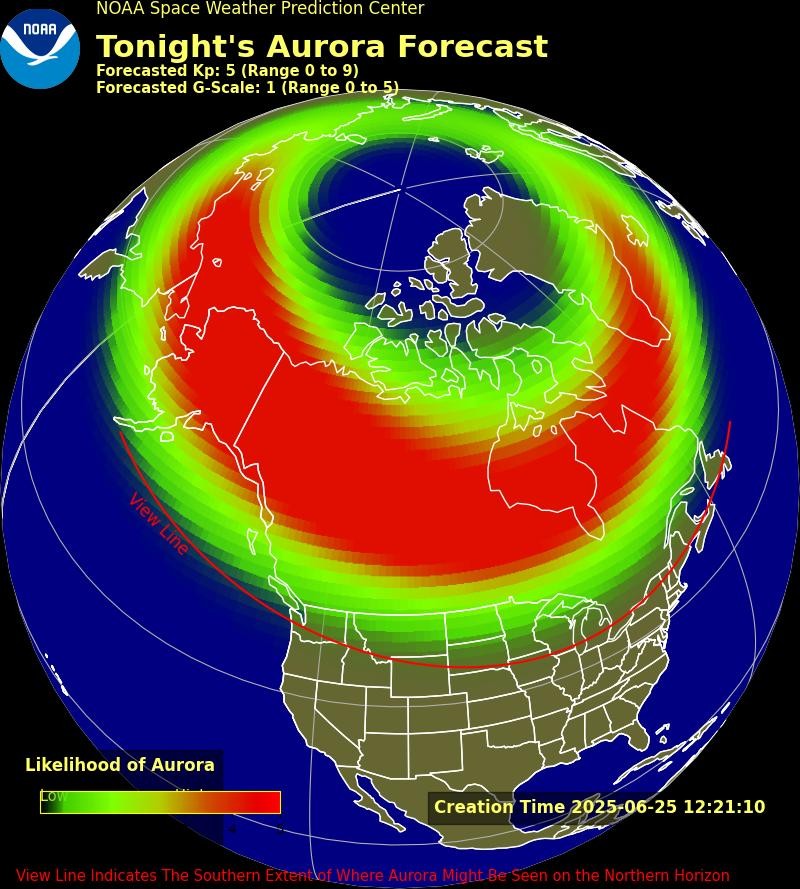Sun 'hole' expected to produce intense auroras tonight, potentially visible from 15 US states
A coronal hole in the sun could result in visible auroras over about 15 U.S. states tonight (June 25), with the Space Weather Prediction Center expecting a moderate geomagnetic storm.

A "hole" in the sun is sending a high-speed stream of charged particles toward our planet, which could make dancing auroras visible from about 15 U.S. states tonight (June 25).
The auroras are predicted to be most intense over Alaska and Canada, but they could potentially also be seen across the north of the contiguous U.S., according to the National Oceanic and Atmospheric Administration's (NOAA) Space Weather Prediction Center.
"The aurora may become visible over some northern and upper Midwest states from New York to Idaho," representatives for the Space Weather Prediction Center wrote in an update.
If skywaters are treated to a northern lights display tonight, it will be thanks to a coronal hole in the sun's atmosphere. These less-dense areas of the sun's outer atmosphere, or corona, enable streams of charged particles, or solar wind, to escape into space at high speeds. When these high-speed streams collide with Earth, they can increase geomagnetic activity, which produces auroras.
The Space Weather Prediction Center is anticipating that the coronal hole streams will trigger a moderate (G2) geomagnetic storm. The geomagnetic storm scale ranges from G1 to G5, with G5 being the most severe. Storms of a G2 magnitude aren't rare but can produce strong auroras.
The U.K.'s Met Office has forecast minor to moderate (G1 to G2) geomagnetic storms on Wednesday, though it noted that a strong G3 storm can't be ruled out.
Related: 32 stunning photos of auroras seen from space
Get the world’s most fascinating discoveries delivered straight to your inbox.
Why do auroras appear?
Auroras occur in the sky when charged particles from the sun hit Earth's upper atmosphere, colliding with oxygen and nitrogen particles. These particles then glow different colors as they shed energy from the collision, according to NASA's Jet Propulsion Laboratory. Oxygen gives off the greens and reds in the auroras, while nitrogen gives off the blue and purple colored light, according to NASA.
The auroras are expected to form above Alaska and Canada, with the light show's southern extent just grazing the northern edge of the contiguous U.S. However, auroras don't have to be directly overhead for people to see them and can be observed from as far as 620 miles (1,000 kilometers) away, according to the Space Weather Prediction Center.

Auroras are typically best viewed just after sunset or just before sunrise. However, they are tricky to predict, and there's no guarantee that people living in northern states will be able to see anything on the northern horizon.
Geomagnetic activity is expected to drop after tonight, with a minor G1 storm forecast for Thursday (June 26), according to the Space Weather Prediction Center.

Patrick Pester is the trending news writer at Live Science. His work has appeared on other science websites, such as BBC Science Focus and Scientific American. Patrick retrained as a journalist after spending his early career working in zoos and wildlife conservation. He was awarded the Master's Excellence Scholarship to study at Cardiff University where he completed a master's degree in international journalism. He also has a second master's degree in biodiversity, evolution and conservation in action from Middlesex University London. When he isn't writing news, Patrick investigates the sale of human remains.
You must confirm your public display name before commenting
Please logout and then login again, you will then be prompted to enter your display name.
